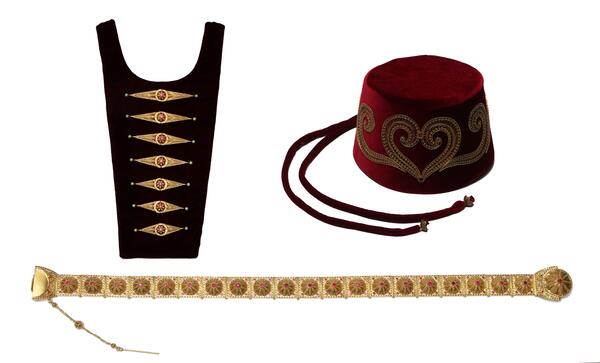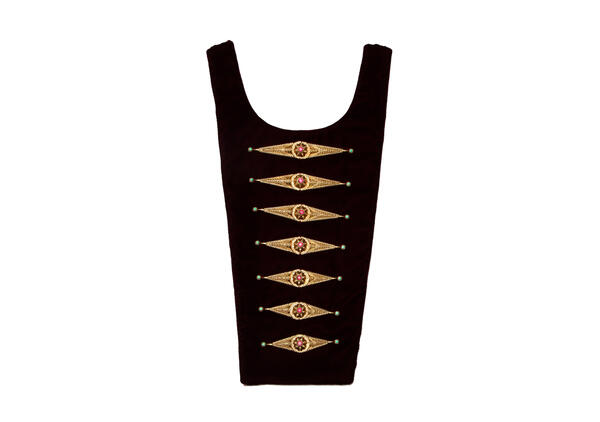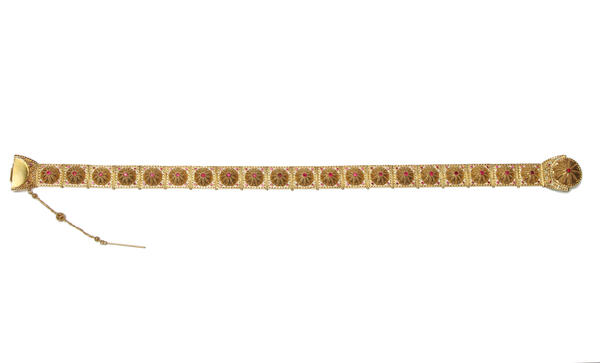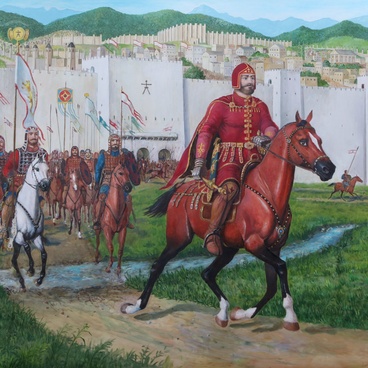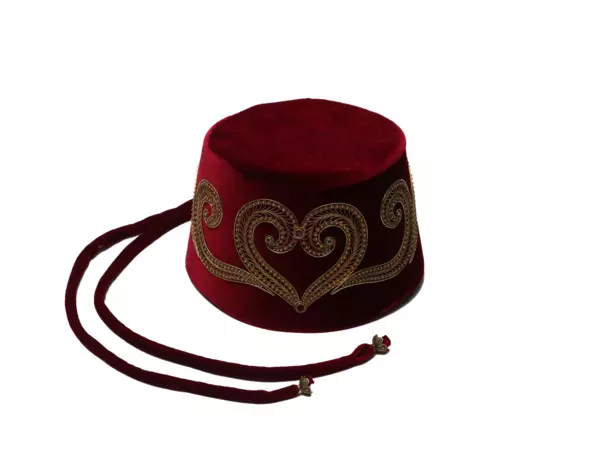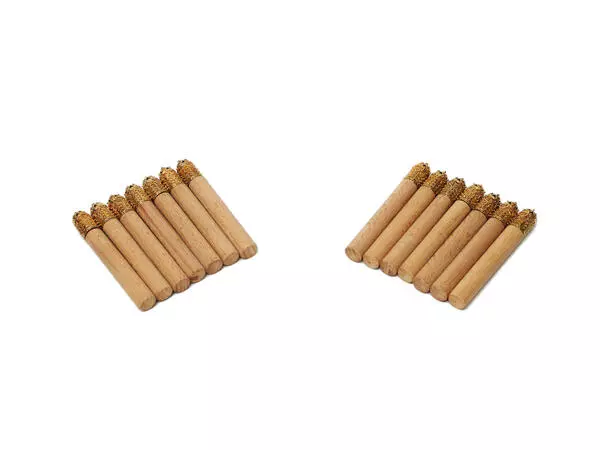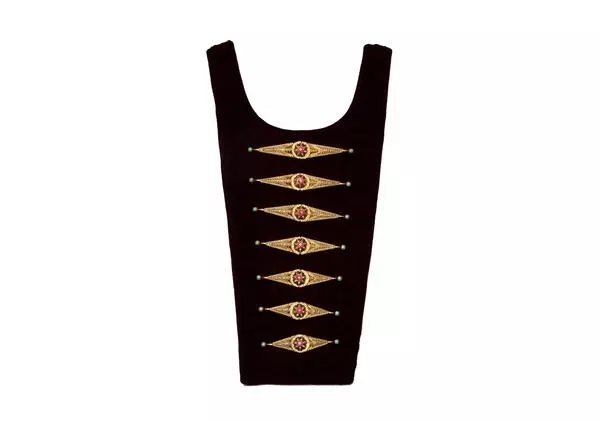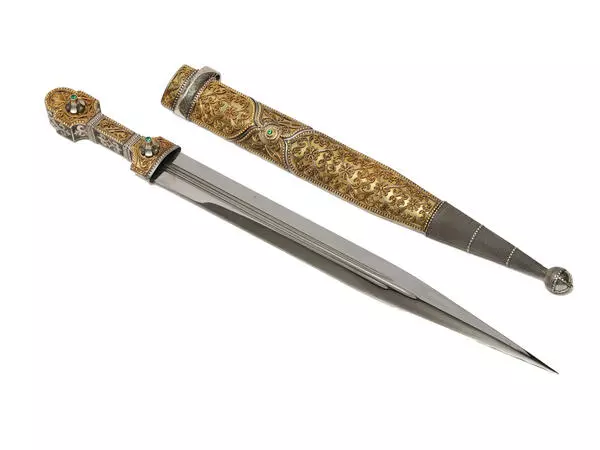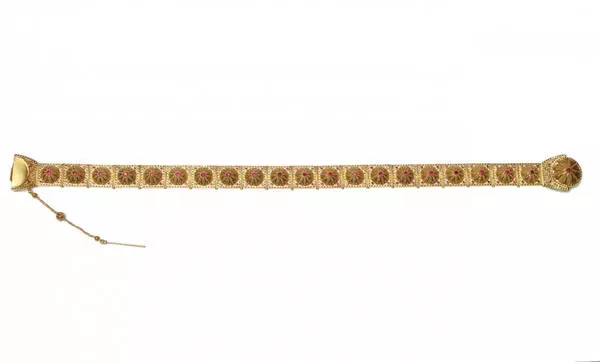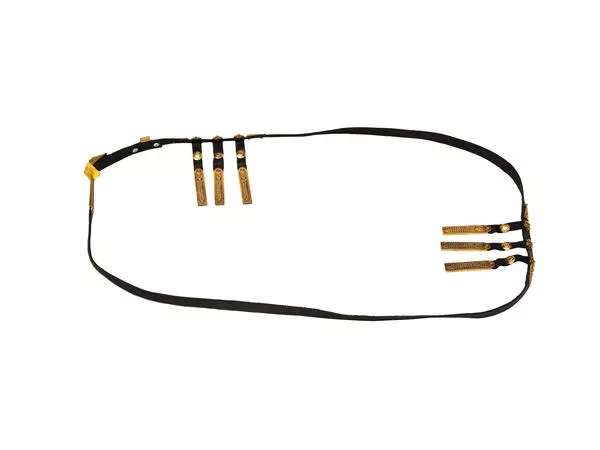Women’s headdresses covered in expensive fabric are called “ega kiy” or “kiy”. This headpiece served as an important part of the wedding dress since the ancient times. The headpieces were shaped like a truncated cone with a flat bottom and decorated with gold and silver metallic patterns.
Over the centuries, Ingushetia developed its own traditions of metalworking. Due to a militarized life, the manufacture of edged weapons was especially valued; however, jewelry was also considered valuable: women’s breastplates and belts, brooches, buttons, medallions, patterns for headdresses, and other elements. The precious wedding sets were inherited and cherished as the most important heirlooms.
Unfortunately, presently, most of the ancient jewelry items have been lost as people sold them for a pittance or exchanged them for food during the challenging times (over the past centuries, the Ingush people have experienced several disasters, including the forced resettlement to Kazakhstan and Central Asia in the middle of the 20th century). But the very secrets of craftsmanship were passed from generation to generation, and today the traditions of the ancestors are continued by artist Bekhan Dakhkilgov.
The artist was born on June 1, 1961, in the village of Dolakovo of the Checheno-Ingush Autonomous Soviet Socialist Republic. As a schoolboy, he simultaneously attended the Republican Art School in the city of Grozny. In his professional development, his family unconditionally supported his choice and helped the young man. The contributions made by his elder brother were significant, as well: he bought specialized literature and helped Bekhan in every possible way to prepare for entering a specialized educational institution.
In 1976, the future jeweler entered the North Ossetian Art School where he chose the department of artistic metal processing. After graduating in 1980, he asked to work for the Chechen-Ingush Art Fund, where he met artist Murat Polonkoev, who was already well-known at that time. He highly valued Bekhan’s hard work and perseverance and presented him with the opportunity to work in his workshop and helped him in everything.
Later on, his brother gifted the artist a portable jewelry equipment kit he bought in Moscow. In those days, it was a lavish gift. The artist still uses some of the tools from this kit.
Presently, Bekhan Dakhkilgov is one of the most famous jewelers of Ingushetia. He strives for perfection in every artwork he creates. He explained that he appreciated the curiosity and broad perspective on life in his colleagues: “Jewelers spend their entire lives with jewelry in their hands, and, therefore, they must know not only the specifics of their work but also have a good knowledge of history. Personally, for instance, I have always been interested in where the traditional Ingush ornaments originally came from, what these or those elements mean.”
Over the centuries, Ingushetia developed its own traditions of metalworking. Due to a militarized life, the manufacture of edged weapons was especially valued; however, jewelry was also considered valuable: women’s breastplates and belts, brooches, buttons, medallions, patterns for headdresses, and other elements. The precious wedding sets were inherited and cherished as the most important heirlooms.
Unfortunately, presently, most of the ancient jewelry items have been lost as people sold them for a pittance or exchanged them for food during the challenging times (over the past centuries, the Ingush people have experienced several disasters, including the forced resettlement to Kazakhstan and Central Asia in the middle of the 20th century). But the very secrets of craftsmanship were passed from generation to generation, and today the traditions of the ancestors are continued by artist Bekhan Dakhkilgov.
The artist was born on June 1, 1961, in the village of Dolakovo of the Checheno-Ingush Autonomous Soviet Socialist Republic. As a schoolboy, he simultaneously attended the Republican Art School in the city of Grozny. In his professional development, his family unconditionally supported his choice and helped the young man. The contributions made by his elder brother were significant, as well: he bought specialized literature and helped Bekhan in every possible way to prepare for entering a specialized educational institution.
In 1976, the future jeweler entered the North Ossetian Art School where he chose the department of artistic metal processing. After graduating in 1980, he asked to work for the Chechen-Ingush Art Fund, where he met artist Murat Polonkoev, who was already well-known at that time. He highly valued Bekhan’s hard work and perseverance and presented him with the opportunity to work in his workshop and helped him in everything.
Later on, his brother gifted the artist a portable jewelry equipment kit he bought in Moscow. In those days, it was a lavish gift. The artist still uses some of the tools from this kit.
Presently, Bekhan Dakhkilgov is one of the most famous jewelers of Ingushetia. He strives for perfection in every artwork he creates. He explained that he appreciated the curiosity and broad perspective on life in his colleagues: “Jewelers spend their entire lives with jewelry in their hands, and, therefore, they must know not only the specifics of their work but also have a good knowledge of history. Personally, for instance, I have always been interested in where the traditional Ingush ornaments originally came from, what these or those elements mean.”

